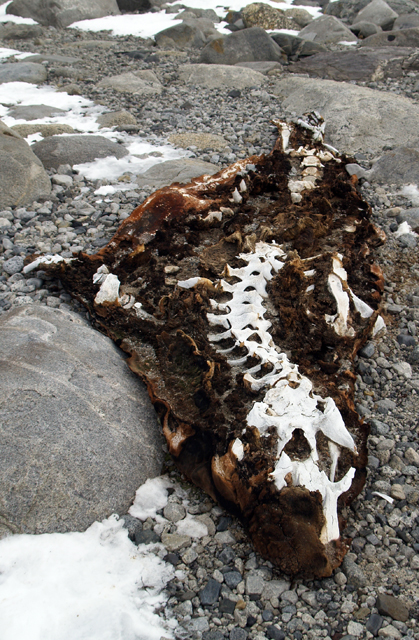Tracking down elephant seal remains turned out to be a difficult taskPage 2/2 - Posted August 7, 2009
There is also some debate, she said, about the current climate trend in the Ross Sea area. Most scientists agree that parts of West Antarctica and the Antarctic Peninsula are warming, but disagreement exists on East Antarctica — a much larger ice sheet that mostly sits on bedrock above sea level, unlike its partner on the other side of the Transantarctic Mountains. From her fieldwork and observations dating back to the 1990s — and that of University of Maine colleague George Denton “It may have been warming a little bit on the coast,” Hall said, but added that a paucity of data makes it difficult to know if the warming is part of a long-term trend or the workings of a natural cycle. A little warmer or colder, one wouldn’t mistake the Victoria Land coast today as a place for a beach vacation, let alone as a location for weeks of fieldwork. Hall and her field team, including co-principal investigator Paul Koch The ancient remains of the animals mostly included skin and hair, along with some bones and skeletons. At first, Hall said, locating the bits of organic material is a bit like a needle-in-the-haystack search. “It’s not at all obvious. People have walked over these beaches for decades without finding it,” she said. “But once you know what to look for, it’s very obvious. Usually it’s under rocks, so you have to get down on your hands and knees and start flipping over a lot of rocks. “There’s a bit of an art to it, I guess, and a bit of luck to it as well,” she added. Rus Hoelzel “We’ve shown how a highly mobile marine species responded to the gain and loss of new breeding habitat. The new habitat was quickly adopted, probably because seals migrate annually into Antarctic waters to feed,” he said. “However, when the ice returned and the habitat was lost, only a small proportion returned to the original source population. The Antarctic population crashed and much diversity was lost.” If climate does warm in the Ross Sea and sea ice again declines as it did in the past, it’s possible the southern elephant seals may return to their abandoned breeding grounds in Antarctica, according to de Bruyn. “But how this warming impacts the present day colonies on Antarctic and sub-Antarctic islands is unknown,” he said. “It could potentially become too warm on these islands for viable colonies, and, of course, the distribution of food resources would be critical to their survival … We don’t know how this is going to change in the future. “Of course, other less mobile species are unlikely to be able to track habitat availability resulting from climate change as efficiently as the elephant seal,” de Bruyn added. “In no way should this research be interpreted as warming being a good thing for southern elephant seals. We don’t understand the dynamics well enough yet.” NSF-funded research in this story: Brenda Hall, University of Maine, Award No. 0439979 |



For USAP Participants |
For The Public |
For Researchers and EducatorsContact UsU.S. National Science FoundationOffice of Polar Programs Geosciences Directorate 2415 Eisenhower Avenue, Suite W7100 Alexandria, VA 22314 Sign up for the NSF Office of Polar Programs newsletter and events. Feedback Form |



